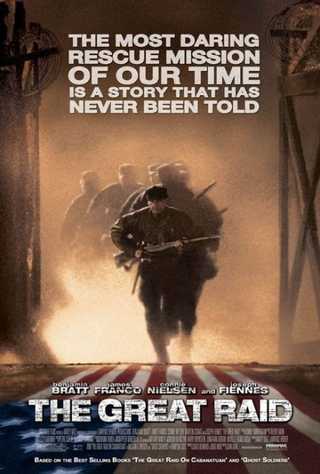The Great Raid
Produced and distributed by Miramax Films, released August 12, 2005, budget of $70 million, color 35mm negative, 1.85:1 screen ratio, digital sound, 125 mins., filmed in Queensland, Australia, and Shanghai, China.
 |
Production:
- Directed by John Dahl
- Written by Carlo Bernard, Doug Miro, based on the William B. Breuer book The Great Raid on Cabanatuan, and the Hampton Sides book Ghost Soldiers
- Produced by Marty Katz, Lawrence Bender
- Original Music by Trevor Rabin
- Cinematography by Peter Menzies
- Film Editing by Scott Chestnut, Pietro Scalia
- Sound Editing by Angelo Palazzo
- Production Design by Bruno Rubeo
- Military advisor Freddie Joe Farnsworth
- Technical advisor Dale Dye
Cast:
- Benjamin Bratt as Lt. Colonel Mucci
- James Franco as Captain Prince
- Joseph Fiennes as Major Gibson
- Marton Csokas as Captain Redding
- Connie Nielsen as Margaret Utinsky
- Logan Marshall-Green as Lt. Paul Colvin
- Robert Mammone as Captain Fisher
- Cesar Montano as Pajota
- Ebong Joson as Captain Joson
- Ken Kikkawa as Commander Tanaka at Palawan POW Camp
- Max Martini as 1st Sgt. Sid "Top" Wojo
- James Carpinello as Cpl. Aliteri
- Mark Consuelos as Cpl. Guttierez
- Craig McLachlan as 2nd Lt. Riley
- Freddie Joe Farnsworth as 2nd Lt. Foley
- Laird Macintosh as 2nd Lt. O'Grady
- Jeremy Callaghan as Lt. Able
- Scott McLean as Lt. LeClaire
- Paolo Montalban as Sgt. Valera
- Clayne Crawford as PFC Aldrige
- Sam Worthington as PFC Lucas
- Royston Innes as Sgt. Adams
- Diarmid Heidenreich as PFC Daly
- Luke Pegler as PFC Miller
- Dale Dye (technical advisor) as General Kreuger
Links:
- Credits from the IMDB for the title The Great Raid
- Official Site
- Sgt. Christina M. O'Connell. Philippines WWII 60th Anniversary commemoration. USARPAC News Feb. 7, 2005
- Col. Randy Pullen. Great Raid on Cabanatuan depicts Warrior Ethos. Army News Service, Aug. 10, 2005
Notes:
This film is based on the true story of the rescue of POWs in the Philippines at the end of World War II. The story was told in the 1994 book The Great Raid on Cabanatuan, by William B. Breuer, and in the 2001 book Ghost Soldiers, by Hampton Sides. The most recent account was given at the 60th Anniversary of the Cabanatuan Raid held Jan. 30, 2005, at the American Battle Monuments Commission Cabanatuan Memorial in Cabanatuan City, Nueva Ecija, Philippines. Sgt. Christina M. O'Connell wrote: "Following the 1945 American forces occupation in Luzon, it was discovered that the Japanese had hundreds of American Prisoners of War held in Cabanatuan. The hundreds of American POWs were the survivors of the 75,000 Filipino and American POWs who survived the infamous 85-mile march out of Bataan in 1942, at which point the Filipino POWs were released and the Americans were shipped to Cabanatuan to work details in 300 acres of farmland under the control of machine guns and 20-foot towers. Executions, disease, beatings and starvation took the lives of more than 3,000 in just a few months. Many more were killed by U.S. aircraft and submarines while being transferred to Japan in unmarked vessels. Just over 500 American POWs were left in Cabanatuan when the 6th Ranger Battalion, led by Lt. Col. Henry Mucci, joined forces with Filipino Guerrillas for flank protection and operational security led by Capt. Juan Pajota and Capt. Eduardo Joson, and the Alamo Scouts who provided forward Reconnaissance and tactical support. With only 48-hours of planning, the joint forces moved out at dusk on Jan. 30, 1945, on a 30-mile walk to the camp in a mission to save the remaining American POWs of Cabanatuan. P-61 Black Widow pilots flew overhead and distracted the guards while the raiders successfully pulled 516 POWs from the camp. While only two Rangers were killed, over 500 enemy troops were wounded or killed during the raid. Without the help of Filipino guerrillas holding back a force of 1,000 approaching enemy troops at the nearby Cabu Highway bridge and the Filipino civilians who provided demobilized prisoners with caraboa carts to ride out of the camp, the mission would have been nothing short of impossible."
